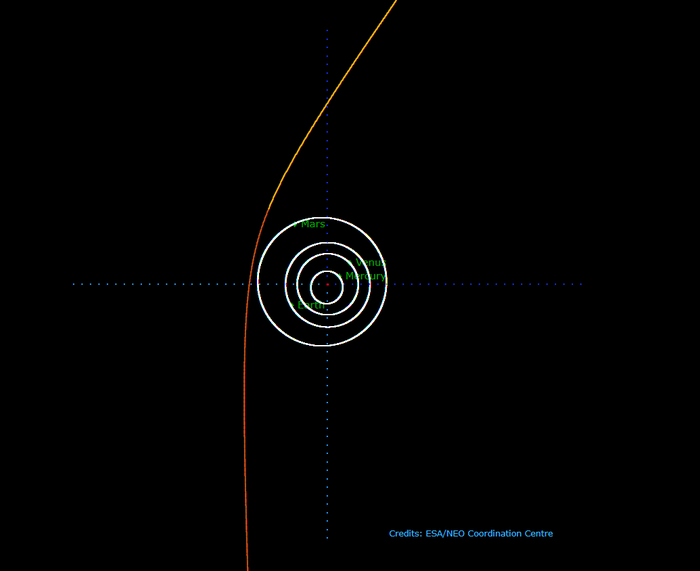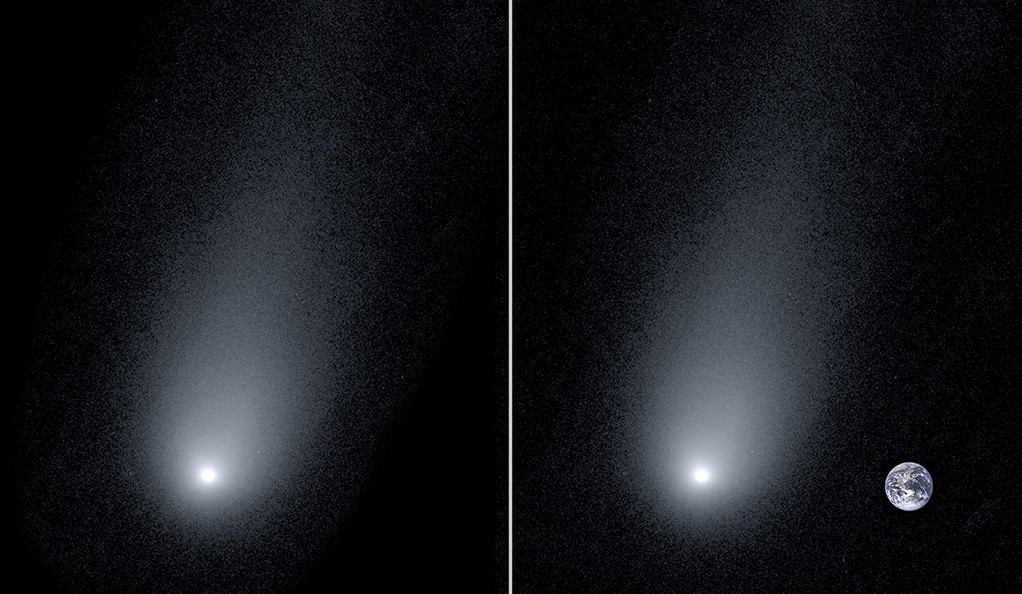Interstellar Comet Borisov Makes Closest Approach to the Sun
It may be visible in small telescopes.

An intriguing interstellar comet from beyond our solar system will make its closest approach to the sun today Sunday (Dec. 8) and may be visible in some small telescopes, according to SkyandTelescope.com.
Comet 2I/Borisov was discovered in late August by amateur astronomer Gennady Borisov. The comet has an extremely extended orbit, which indicates it came from outside our solar system, beyond the sun's influence.
The interstellar comet is expected to reach perihelion (closest approach to the sun) today, at which point it will travel about 2 astronomical units (AUs) from the sun. One AU is the average distance between Earth and the sun, about 93 million miles (150 million kilometers). The comet will then pass closest to Earth a few weeks later on Dec. 28.
Interview: How Gennady Borisov Discovered an Interstellar Comet
More: Hubble Telescope Spots Interstellar Comet Borisov (Video)
Observations show that Borisov has a small, bright head with a faint, extended tail, and its surface is reddish in color. The comet is expected to reach a visual magnitude peak of 15 during perihelion, suggesting it may be visible using an 8 or 10-inch telescope under clear skies, according to SkyandTelescope.com.
"Right now, Comet Borisov is small and compact with a short tail pointing northwest. If the comet remains compact or nearly stellar and reaches magnitude 15.0, experienced observers might spot it in a 10-inch [telescope]," according to SkyandTelescope.com. "Chances improve for telescopes 12 inches (30.5-cm) or larger under dark, moonless skies. Equally important is to use high magnification to 'expand' the small object and further darken the sky background."
Related: Interstellar Comet: Here's Why It's Got Scientists So Pumped Up
Get the Space.com Newsletter
Breaking space news, the latest updates on rocket launches, skywatching events and more!




As Borisov passes by the sun, its possible that the comet may release vaporized ice and dust, which would temporarily cause the comet to increase in brightness. However, it's also possible that the comet could break up and disintegrate from the sun's radiation, like comet ISON.
Based on the comet's speed and trajectory, astronomers believe that it came to our solar system from afar. It arrived traveling at speeds of 33 km/s, but is expected to reach a peak velocity around 44 km/s at perihelion.
Comet Borisov is only the second interstellar minor body to be observed in our solar system, following the mysterious cigar-shaped object named 'Oumuamua, which was first spotted in October 2017. Researchers will continue to track Borisov as it makes its way through the solar system and hopefully identify where the comet came from.
- We Could Chase Down Interstellar Comet Borisov by 2045
- This Comet Might Be from Interstellar Space. Here's How We Could Find Out.
- 1st Color Photo of Interstellar Comet Reveals Its Fuzzy Tail
Follow Samantha Mathewson @Sam_Ashley13. Follow us on Twitter @Spacedotcom and on Facebook.

Join our Space Forums to keep talking space on the latest missions, night sky and more! And if you have a news tip, correction or comment, let us know at: community@space.com.

Samantha Mathewson joined Space.com as an intern in the summer of 2016. She received a B.A. in Journalism and Environmental Science at the University of New Haven, in Connecticut. Previously, her work has been published in Nature World News. When not writing or reading about science, Samantha enjoys traveling to new places and taking photos! You can follow her on Twitter @Sam_Ashley13.
-
rod I enjoy these reports on 2I/Borisov comet. Starry Night Pro Plus 8 software is updated, showing the comet and sky chart views. At my location below 39 degrees north latitude, the comet currently rises near 0130 EST. Looking ahead to 28-Dec-19 close approach to Earth, this comet is visible with large telescopes 0300-0530 EST. I love looking at 0400 comets. So much fun to be outdoors with the deer, foxes, owls, and skunks moving around :)Reply -
dpc This story is nice. Super interesting. But you need to correct a major mistake.Reply
This is not correct: "Comet Borisov is only the second interstellar minor body to enter our solar system..." It is the second *observed* interstellar body. It's predicted that these pass through frequently. In the history of our solar system, millions or perhaps billions have passed through. As our ability has improved to observe, we've already seen two in just a couple years. This happens all the time! Super cool that we are finally observing and studying them, but it is *not* only the second one to happen. (Or, when a tree falls in a forest, and no one is there to observe it... it's still fallen. When a comet or other body swings through the solar system from afar and no one observes it (or before humans even evolved to bear witness), it was still happening.)
Thanks for the interesting story. Sorry to nitpick, but that really is a major error of fact that should be corrected. Easy mistake to make (a lot of reporting now and a couple years ago did the same), but also important to do better. -
rod Replydpc said:This story is nice. Super interesting. But you need to correct a major mistake.
This is not correct: "Comet Borisov is only the second interstellar minor body to enter our solar system..." It is the second *observed* interstellar body. It's predicted that these pass through frequently. In the history of our solar system, millions or perhaps billions have passed through. As our ability has improved to observe, we've already seen two in just a couple years. This happens all the time! Super cool that we are finally observing and studying them, but it is *not* only the second one to happen. (Or, when a tree falls in a forest, and no one is there to observe it... it's still fallen. When a comet or other body swings through the solar system from afar and no one observes it (or before humans even evolved to bear witness), it was still happening.)
Thanks for the interesting story. Sorry to nitpick, but that really is a major error of fact that should be corrected. Easy mistake to make (a lot of reporting now and a couple years ago did the same), but also important to do better.
Models of comets entering our solar system that originated from other stars - are models, not scientific fact. The two comets confirmed or interpreted as interstellar today are understood as such because of their orbits and eccentricity (very hyperbolic), this is an actual comet sighting but the parent star is not clearly established as to where the comets came from. A comet originating at a star 13 light-years distance for example and traveling at 20 km/s, will take 195,000 earth years to reach our solar system - if it does.









